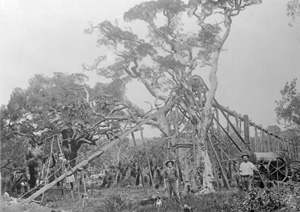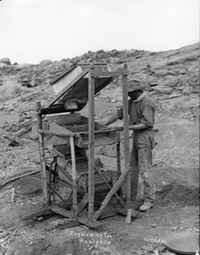|
Tin
Mining of the first deposits of tin found in Western Australia at Greenbushes, near Bunbury, began in 1889. By the start of the twentieth century the newly
developed industry had come through a decade of poor tin prices and mining laws which made it difficult to get title for any mineral other than gold. Gold prospectors moving from Halls Creek to the East Pilbara in 1889
had found many deposits of alluvial tin near Marble Bar, but no tin was mined outside Greenbushes until 1893 at Shaw River.
In the early 1900s higher tin prices meant that mining of mainly alluvial deposits had begun at fields such as Moolyella (1898), Cooglegong (1900) and Wodgina
(1902). With all of these mines production levels peaked early and then fell away after 1910. One drawback for miners was that the method used to extract the tin
concentrate from ore required water. Although relatively abundant at Greenbushes in the South West, a shortage of water hampered production in the Pilbara resulting in tin miners leaving lower grade ore unprocessed.
By 1920 tin mining experienced a slump which lasted for more than three decades. Until the mid 1950s most tin
production in the State came from mines worked by small syndicates and individual prospectors. After the Second World War a recovery in world tin prices and the introduction of earth moving machinery improved the
profitability of low grade ore deposits in the Pilbara resulting in a small tin boom centred around Marble Bar from 1957. Production there peaked in 1967, around the
same time a new deposit of tin was discovered at Coondina (1966). There was also renewed interest in working the Greenbushes site which was reopened in 1966 using
dredge-bucket mining at first and then open cut mining from the early 1970s.
At the end of the twentieth century the main method of mining large tin deposits was by bucket-line dredging, a far cry from the early shaft mining used at
Greenbushes. Dredging excavates and transports the ore by a continuous chain of buckets to the interior of the dredge, where it is washed and roughly concentrated. The tin ore is further concentrated by
gravity, passing it in a stream of water over equipment such as jigs, spirals, and shaking tables. Finally magnetic or electrostatic separation removes the heavy mineral impurities.
By the 1990s Sons of Gwalia company owned and operated the Greenbushes mine which produced 600 tonnes of tin for the year ending June 1999. The metals lithium,
tantalum and tin are commonly found together. Although tantalum was recognised in many of the early tin mine workings, a market was only created by the invention of the
tantalum filament for electric lights in 1905. In addition to producing tin Greenbushes is the world’s largest tantalum mine, as well as being the only hard rock tantalum mine in the world.
|
|









